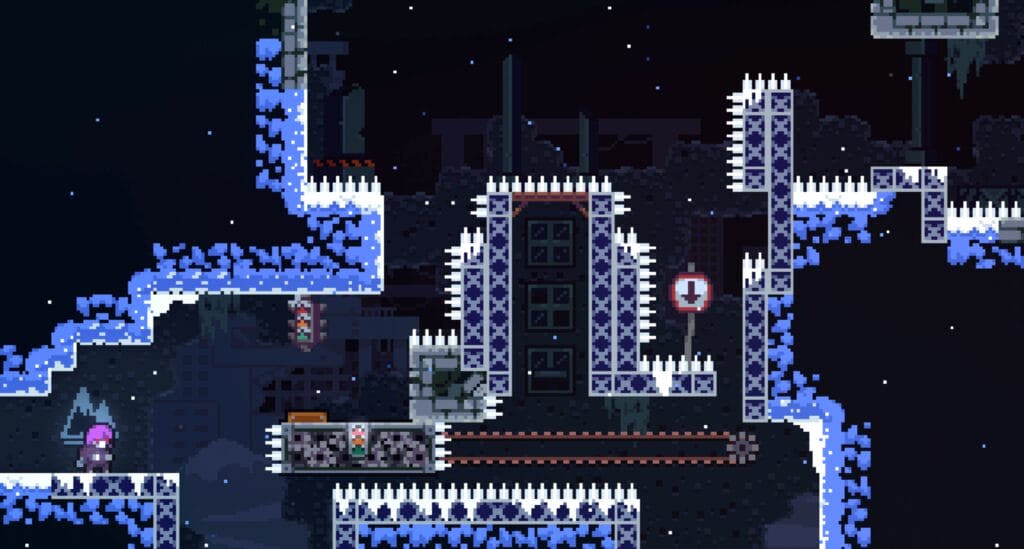Balancing video game difficulty is both a science and an art. The ultimate goal is an experience that challenges players’ skills while avoiding feelings of frustration and unfairness. In this comprehensive guide, we’ll explore the nuances of difficulty progression, key balancing techniques, and case studies of games that nailed compelling challenge.
Contents: Adjusting Game Difficulty & Game Balance
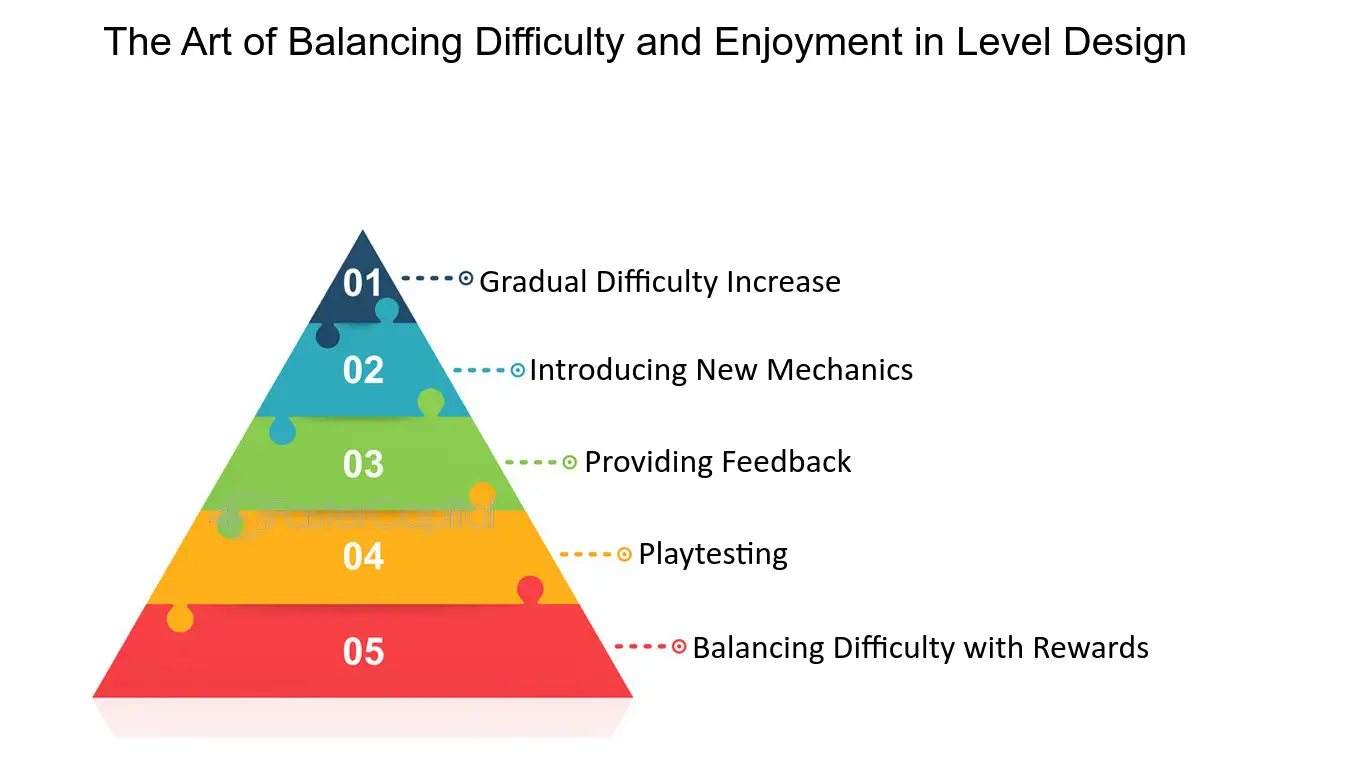
Game Design
Game design involves crafting engaging gameplay through well-balanced mechanics, systems, and challenges. Game developers must carefully balance all the elements of a game to create an experience that is fair, satisfying, and appropriately challenging for players. Good balance depends on the game genre and target audience. For example, competitive games need to ensure no single strategy or mechanic gives some players an unfair advantage. RPGs should balance character classes and abilities so no build feels too powerful or too weak. Ongoing playtesting and player feedback helps identify imbalances in the game design so developers can make adjustments and improve the overall gameplay experience.
Game Difficulty
Game difficulty refers to how challenging it is for players to succeed and make progress within a video game. It involves the combination of various gameplay elements that collectively determine the level of challenge faced by players. The difficulty ultimately impacts how much effort, skill, and time is required for players to achieve objectives and complete the game.
Some ways game difficulty can be measured and quantified include:
- Enemy strength – Factors like health points, damage inflicted, accuracy, and aggression. Stronger enemies equal higher difficulty.
- Frequency of obstacles – Density of hazards, traps, puzzles and other impediments to progress. More frequent obstacles increase difficulty.
- Length and complexity of levels – Long levels with complex layouts are more difficult than short, linear ones.
- Limited resources – Restricted health, ammo, abilities, etc. adds difficulty through scarcity and forcing prudent use.
- Speed and precision required – Games requiring fast reflexes or accurate timing are more difficult than slower-paced games.
- Death penalty – The in-game penalty for player death affects how costly failure is. Higher death penalties increase difficulty.
- Optional objectives – Secondary goals like speed run targets or keeping NPCs alive add challenge.
- Adaptivity – Games that dynamically adjust based on player skill have flexible difficulty.
By tuning these elements, designers can shape the difficulty curve and overall challenge profile that players will experience. Extensive playtesting provides data to help quantify and calibrate difficulty. The goal is to find the optimal level of challenge that satisfies players’ needs for engagement without excessive frustration.
Game Balance
Game balance refers to how different elements and mechanics in a game interact to provide players an equal chance of winning based on skill rather than artificial advantages. Game designers use iterative playtesting and metrics to balance their games. If some aspect is too powerful or too easy, the designer can increase difficulty or nerf the imbalanced element. The goal is to achieve “perfect balance” where no single strategy dominates and players of different skill levels can compete fairly. However, perfect balance is elusive in complex games, so designers must continually test and tweak based on player feedback to smooth out issues. A well-balanced game feels fair and provides players agency to overcome challenges with their own skill.
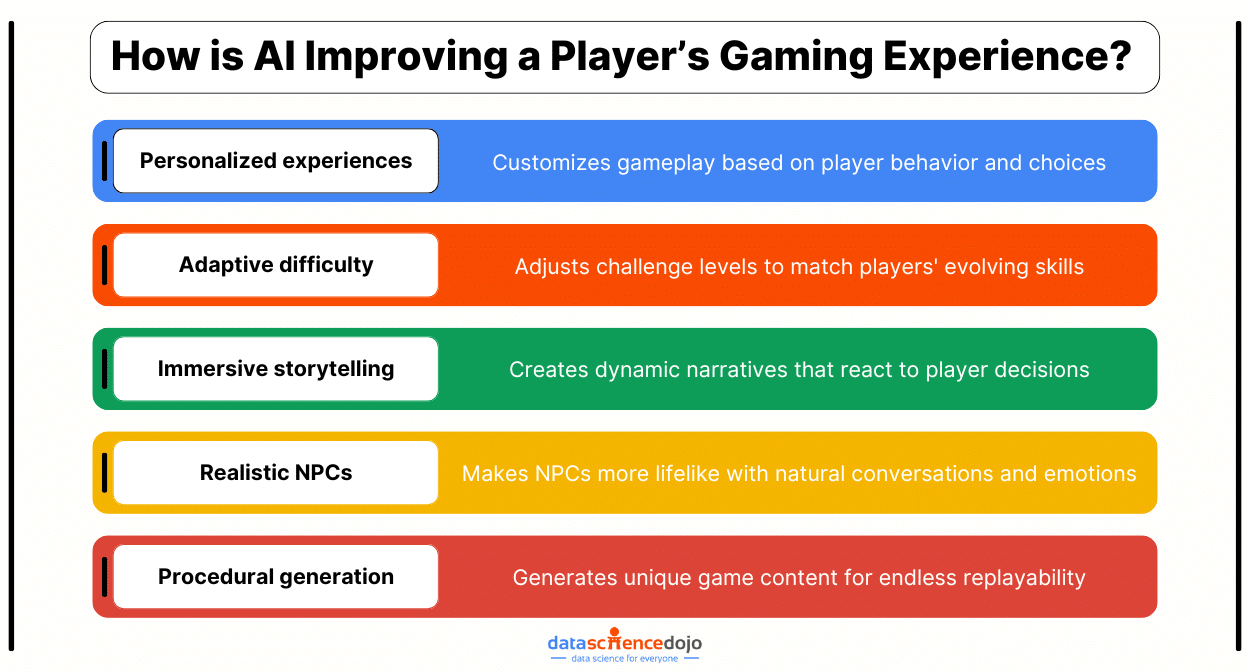
Artificial Intelligence (AI) for Behaviors
Incorporating AI enemies and opponents is an important aspect of game balance. AI needs to act realistically based on game contexts without seeming too omniscient or behaving illogically. At lower difficulties, the AI can be less efficient and aggressive to give the player a smoother onboarding experience. At higher difficulties, expert systems and machine learning can enable challenging AI that provides a stiff but still surmountable challenge. Dynamic difficulty adjustment based on player performance further helps balance AI strength. Playtesting against the AI reveals imbalances that can then be tweaked through its decision-making systems and game data. Balanced AI provides robust challenges without feeling unfair.
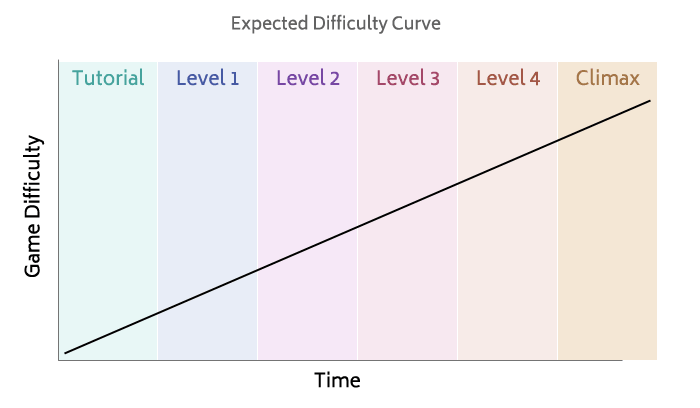
Foundations of Engaging Difficulty Curves
Before diving into specific tactics, let’s establish core principles that drive effective difficulty balancing:
Match Difficulty to Target Audience
- Casual mobile games need more forgiving difficulty than hardcore shooters aimed at pro gamers. Know your audience first.
Gradually Ramp Up The Challenge
- Starting simple and slowly increasing difficulty over time provides a smooth, natural progression.
Allow Control Over Difficulty Level
- Giving players options like easy/hard modes caters to different skill levels.
React to Player Skill Dynamically
- Adaptive games track progress and tweak difficulty on the fly to maintain engagement.
Telegraph Spikes Before They Happen
- Warn players before sudden surges in difficulty so they can prepare rather than feel blindsided.
Provide Tools to Overcome Obstacles
- Power-ups, gear improvements, or upgrades give players agency to eventually conquer tough challenges.
Support Multiple Strategies
- Avoiding forced, narrow solutions allows different playstyles and keeps difficulty manageable.
Refine Based on Playtesting
- Watching testers provides invaluable feedback for smoothing out difficulty spikes.
Adhering to these core principles ensures your difficulty progression stays smooth, fair, and rewarding for players. Now let’s see them applied through specific game balancing techniques.
“Easy to learn, hard to master is a great rule of thumb when designing game difficulty.”
– Sid Meier, creator of Civilization series

Techniques for Smart Difficulty Balancing
Game designers employ a variety of methods to keep challenge and progression engaging from start to finish.
1. Gradually Escalate Enemy Strengths and Abilities
Rather than start with the toughest enemies, gradually escalating their health, damage, speed, aggression, and cognitive abilities over time maintains a steady difficulty climb:
- Health: Increase enemy health pools so they take more hits to defeat. For example, standard Goombas may die in one hit early in a Mario game, while later enemies can withstand much more damage.
- Damage: Boost the amount of damage enemies inflict with their attacks. This compensates for the player getting more health/defenses.
- Speed: Faster enemy movement and attacks force players to react quicker and aim with greater precision.
- Aggression: Enemies that actively chase, flank, ambush or focus fire on the player present more pressure than passive foes.
- AI/Patterns: More sophisticated enemy behavioral logic like dodging, coordinated attacks, combos, or reacting to player moves requires mastery to overcome.
Smart sequencing of enemy attributes maintains tension while allowing the player time to hone their skills in response to each escalation.
“If you want players to feel smart, first you need to make them feel stupid.”
– Jonathan Blow, creator of Braid
2. Increase Environmental Hazards and Obstacles
In addition to enemies, increasing the challenges presented by the surrounding environment creates organic difficulty progression:
- Traps: Floating spikes, flamethrowers, or gun turrets that damage the player raise the risks.
- Hazards: Lava, icy or slippery surfaces, falling debris that must be avoided create time pressure.
- Puzzles: More complex mechanical puzzles or riddles that block progress require mental dexterity.
- Platforming: Jumping over gaps, navigating disappearing platforms, or moving surfaces demand precise timing and accuracy.
Choreographing environmental challenges forces players to engage with broader mechanics beyond combat, diversifying the skills needed to succeed.
“Your game design is like a recipe. You have to adjust the ingredients until the flavor is just right.”
– Jenova Chen, creator of Journey
3. Limit Resources and Impose stringent Objectives
Constraining resources or tightening objectives pressures players into mastering efficient play:
- Health/lives: Restricting health packs/regeneration or limiting lives/continues compels caution and risks each mistake.
- Ammo/mana: Low ammo or mana for weapons/abilities necessitates careful ability use rather than spamming attacks.
- Time limits: Racing against the clock or timed missions promote quick thinking and reflexes.
- Visible stalkers: Pursuing enemies that can track player location, like the Nemesis in Resident Evil 3, force efficient routing and resource management.
- Secondary objectives: Optional challenges like keeping NPC allies alive or speed run targets test mastery and skill.
Imposing restrictions allows designers to demand more from players without just making enemies stronger.
4. Offer Temporary Power-ups
Temporary boosts help players overcome surges in difficulty or defeat strong enemies requiring abilities not yet earned:
- Damage/speed increase: Short bursts of faster attacks or increased damage let players blaze through waves of tough foes.
- Invincibility: Brief periods of invulnerability provide a safe window to attack without worry of death by strong enemies or environmental hazards.
- Enemy slowdown: Slowing enemies allows easier dodging of complex attack patterns.
- Environmental effects: Neutralizing dangers like freezing lava provides reprieve from ever-present threats.
- Alternative paths: Secret paths that bypass challenges offer temporary relief for struggling players.
Power-ups enable designers to spike difficulty for a section while giving players tools to persevere through it.
“The tuning and tweaking will never be over. But remember to listen to your players – their difficulties can reveal your oversights.”
– Robin Hunicke, co-creator of Journey
5. Telegraph Impending Difficulty Spikes
When ramping up to an exceptionally tough boss battle or dungeon, provide visual, audio and narrative hints that severe challenges lie ahead:
- Visual cues: Flashing backgrounds, ominous lighting, cracking floors or shaking screens imply imminent danger.
- Sound cues: Dissonant music, rumbling sounds or discordant noises evoke unease before major threats.
- Narrative hints: Dialog suggesting the upcoming encounter will require special preparations or is unusually dangerous sets expectations.
- Environmental changes: Entering areas with stronger enemies forewarns of greater resistance ahead. A twisted, hellish landscape implies very lethal foes.
- Save points: Generous placement of save points before hard sections provides a safety net, allowing the spike to feel epic rather than punitive.
Proper telegraphing prevents difficulty spikes from feeling jarring or unfair. Players appreciate knowing what they are getting into beforehand.
6. Provide Multiple Options
Where appropriate, avoid funneling players down a single path or playstyle by offering options:
- Stealth vs combat: Let players sneak past enemies or confront them directly. Dishonored epitomizes this approach.
- Shortcuts: Hidden or challenging paths that let players bypass sections cater to speedrunner playstyles.
- Class builds: RPGs with flexible skill trees allow specializing as mages, archers, tanks etc. based on preference.
- Branching story: Narrative choices that lead to different endings or scenarios maintain engagement across playthroughs.
- Secrets: Rewarding exploration and discovery of hidden power-ups, lore or unlockables gives incentive to re-explore.
Providing degrees of freedom keeps all types of players invested regardless of skill level or playstyle preferences.
“Not every player wants to prove themselves on the hardest setting. Options ensure anyone can have fun.”
– Toby Fox, creator of Undertale
7. Tutorialize Core Mechanics
Ensure players fully understand core mechanics before introducing high-difficulty applications of those mechanics:
- Isolated skill introduction: Early levels isolate specific mechanics like jumping, shooting or using cover to develop competency before combining skills.
- Low-stakes failures: Design early sections where failure poses minor consequences, allowing risk-free practice.
- Pop-up hints: Brief pop-up messages that remind players of controls or tips reinforce learning. Don’t overdo it though.
- Audio callouts: Voiced hints related to context reinforce how and when to apply mechanics.
- Videos: Some games integrate short video clips that demonstrate advanced techniques players can aspire towards.
Fluency with core mechanics is necessary to tackle the evolving challenges a game will throw at you. The initial learning curve must be gentle.
“Assist modes open games to players who might otherwise bounce off harsh difficulty walls.”
– Matt Thorson, creator of Celeste
8. Maintain Consistent Challenging Pacing
A common pitfall is huge contrasts between intense high-stress sections and lengthy dull lulls. Strive for steady pacing variances:
- Prevent lulls: Ensure even transitional areas between major battles have some degree of threat to sustain tension.
- Limit burnout spikes: Avoid difficulty spikes so extreme they exhaust players and need long breaks before continuing. Challenge in moderation.
- Manage resources: Health, ammo, mana should be just enough to overcome each encounter and require prudent use rather than abundant.
- Checkpoints: Well-placed checkpoints prevent having to replay long easy sections before reaching difficult areas that defeated players.
- Diversify challenges: Vary encounter types and locations to refresh the experience rather than extensive repetition.
Consistent pacing prevents boredom or player burnout. Downtime should rebuild engagement rather than lose it.
9. Adapt Difficulty Dynamically
Rather than a pre-defined difficulty curve, modern games can respond to player performance in real-time by:
- Leveling enemies alongside players: Enemies grow stronger as the player levels up to maintain relative challenge. Popular in RPGs.
- Conditional spawning: Spawn more, stronger enemies if the player defeats foes with ease or has high health/resources.
- Performance-sensitive rewards: Scale experience point rewards based on speed, damage taken, or other skill indicators.
- Rank/grading: Evaluate the player’s performance to assign a letter grade, star rating or score used for conditional unlocks.
- Removal of aids: As players improve, disable aim assists, tutorials, level indicators or other newbie helps.
Dynamic systems ensure challenge remains high regardless of skill differences between players.
“If everything is overpowered, nothing is overpowered.”
– David Sirlin, designer of Super Street Fighter II Turbo HD Remix
10. Provide Difficulty Options
Where feasible, support custom difficulty selections:
- Difficulty levels: Explicitly choosing Easy, Medium, Hard modes that tweak values like damage taken/dealt, enemy aggressiveness, etc.
- Menu options: Enable toggling individual assists like aim help, wallhack radar, infinite ammo, and other modifiers.
- Difficulty sliders: For a continuous range, use sliders to tweak health, damage and other values.
- Character builds: Classes tailored towardsdifficulty, such as mages having an easier start compared to warriors.
- Hidden options: Secret cheat codes or unlockables that reduce difficulty, extend time limits or reveal hidden paths. Reward progression.
Giving players control over the experience caters to different skill levels and playstyles while still providing escalating challenges.
11. Provide Assistance Mechanics
Optional abilities or mechanics that smooth out difficulty spikes and training wheels for struggling players include:
- Companion characters: Allies that provide buffs, distractions or protection compensate for lack of player skill.
- Summoning: Allow calling computer or player controlled allies into the game world for aid.
- Difficulty decreasing consumables: Items that restore health or reduce damage taken help overcome near-impossible situations.
- Gain experience faster: Temporary boosts to experience gain accelerate player power improvements.
- Skip functions: Let players bypass frustration points through options like cutscene skips or paying in-game currency to auto-win fights.
- Aim assists: Magnetism, sticky aim and auto lock-on abilities compensate for lack of player precision.
Assists enable a wider range of players to experience full games. They can be disabled later as players improve.
By combining techniques like these, designers can deliver polished difficulty curves tailored to their specific game and players. Next we’ll examine some case studies of popular games praised for their challenge balancing.
“In asymmetric competitive games, make sure everyone feels like they have a chance to win.”
– Mark Rosewater, Magic the Gathering designer
Case Studies of Masterful Difficulty Balancing
Let’s look at a few noteworthy examples of games that really nailed the escalation and maintenance of engaging, rewarding difficulty.

Celeste
This tough 2D platformer excels at balancing extreme challenge with accessibility through smart difficulty options. Features include:
- Assist mode: Makes the game easier in many ways like reducing damage taken, increasing air dash count, and slowing the game speed.
- Dynamic difficulty: Optional setting that adapts the game’s challenges based on player death count. Reduces spike frustration.
- Simplified levels: Alternate versions of particularly brutal levels with simpler layouts and obstacles to overcome.
- Strawberries: Collectible items that encourage exploration without locking progress behind intense platforming challenges. Finding them is optional.
- Frequent checkpoints: Saves progress constantly to avoid punishing players for mistakes by forcing big sections to be repeated.
Celeste allows both casual and hardcore gamers to experience its exceptional platforming. It respects players’ time while still offering hardcore challenge for those who want it.

Cuphead
This brutally challenging shooter uses visuals, audio, and level design to effectively telegraph spikes in difficulty:
- Unique visuals: High contrast hand-drawn art style makes hazards and enemies pop visually so players can react quickly.
- Color coding: Levels get darker and more ominous looking as the difficulty increases. The visual language is clear.
- Musical flair: Catchy jazz music shifts to tense dissonant tones during particularly dangerous segments.
- Tight level segments: Short playable sections with bosses at the end avoids draining player stamina too much at once.
- No health regen: Restricted health pickups force cautious, thoughtful play rather than recklessness since health doesn’t auto-restore.
Cuphead prepares players thoroughly for its intense difficulty through its highly responsive design. Challenges feel surmountable once you learn the patterns.
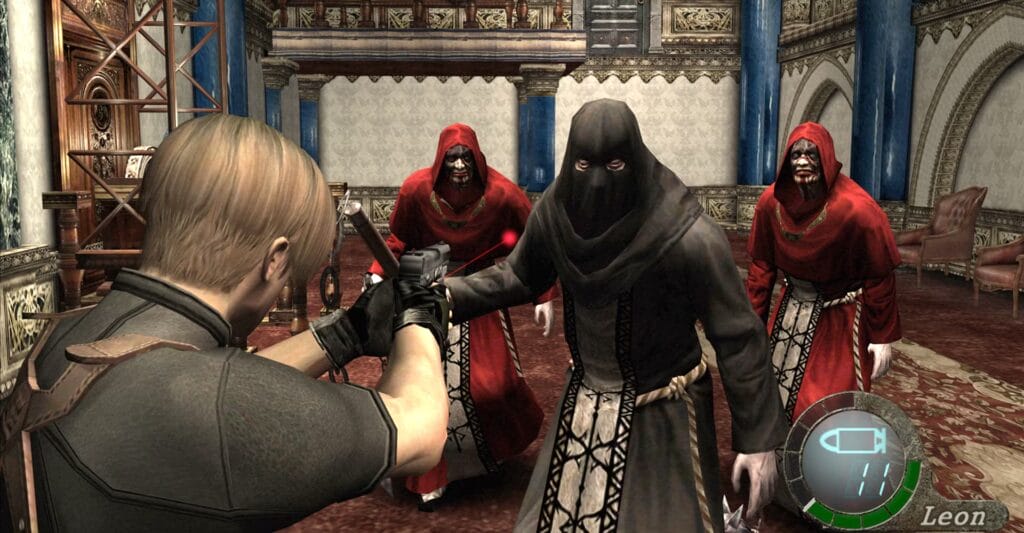
Resident Evil 4
This survival horror classic spikes and relaxes tension through clever pacing and resource scarcity:
- Wave encounters: Hordes of enemies attack in waves of manageable sizes rather than endless groups, providing short breaks to reload.
- Ammo scarcity: Limited ammo creates constant pressure to aim accurately and make shots count. Ammo drops are barely enough to get by.
- Weapon upgrades: New guns acquired feel stronger at first, but enemies also grow tougher, so challenges scale up in parallel.
- Checkpoints: Frequent quick save points reduce frustration of dying and having to repeat long sections.
- Safe rooms: Safe hub areas between intense segments offer supplies and a chance to breathe and strategize before continuing.
RE4’s pacing provides peaks and valleys of difficulty, never letting the player get too comfortable. The focus on resource management keeps tension high.
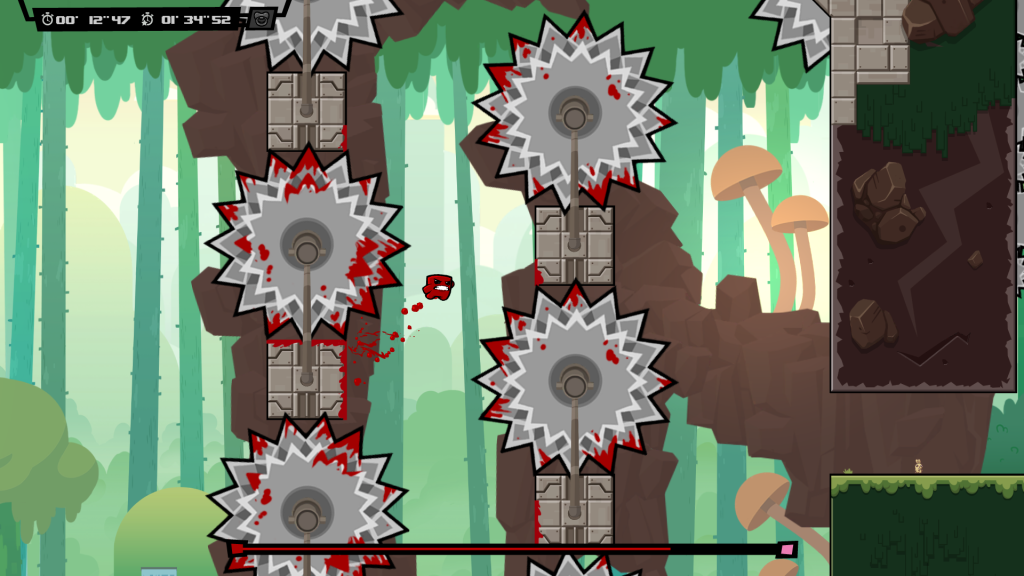
Super Meat Boy
This ultra-hard platformer succeeds by keeping failures rapid and frequent but low frustration:
- Precise controls: Meat Boy’s controls are super responsive, so players know failures are due to skill rather than clunky inputs.
- Near-instant restarts: When you die, levels restart in about 1 second, keeping the flow going and reducing tedium.
- Frequent checkpoints: Most levels are completed in less than a minute, with checkpoints halfway. This minimizes repetitive sections.
- Short levels: Bite-sized levels avoid the fatigue of marathon play sessions, encouraging “one more try” persistence.
- No lives system: Dying doesn’t incur any penalties or force you to see a game over screen. You just immediately restart.
Super Meat Boy embraces difficulty through its fast-paced design that gets players back into the action instantly after they fail.
“The right pace of challenge keeps players in the zone, neither bored nor frustrated.”
– Goichi Suda, No More Heroes designer
Key Takeaways for Balancing Difficulty
Here are some top level guidelines to keep in mind when developing and tuning difficulty progression in your game:
Understand the Target Player
Not all games should be punishingly hard. Consider the audience and genre when deciding on challenge levels. Balance around the expected player skill range.
Telescope Challenges
Give clear visual and gameplay indicators that prepare players for spikes in difficulty before they happen to avoid surprises.
Fail Faster, Retry Faster
Minimize frustration by getting players back into action quickly after failures rather than interrupting flow with loading screens or game over screens.
Create Handles for Struggling Players
Where possible, implement difficulty settings, optional power-ups or accessibility options to help weaker players overcome roadblocks and continue enjoying the core experience.
Maintain Engagement Pacing
Avoid wild spikes and lulls. Even easier sections should retain some degree of threat to sustain engagement. Difficulty spikes should seem daunting but achievable.
Playtest Extensively
No amount of theory or design docs can replace playtesting. Watching real players encounter challenges provides the best feedback for refining balance and flow.
Conclusion: Adjusting Game Difficulty & Game Balance
Balancing difficulty is crucial to creating rewarding gameplay, but it is as much art as science. While there are many techniques and principles to guide difficulty design, ultimately what works best depends heavily on the specific game, target audience, and desired experiences.
That said, a few universal best practices apply. Smooth upward difficulty curves with clearly telegraphed spikes prevent frustration. Checkpoints and generously placed power-ups give struggling players a fighting chance without compromising overall challenge. Extensive playtesting provides invaluable data to identify sticking points.
Adaptive systems that respond to player performance take some of the guesswork out of manual balancing. Options to tweak difficulty settings empower players to customize the experience to their skills and needs.
For competitive games, balance should give skilled players an edge without conferring unfair advantages. Cooperative and single player experiences should strive for an intensity sweet spot that immerses without overwhelming players.
Perfect balance may be unattainable, but the pursuit itself important. Players deeply appreciate games that are thoughtfully challenging. Mastering a tough but fair game provides an extremely rewarding feeling of accomplishment. That lofty target should motivate developers to keep refining balance throughout the game lifecycle.
With care, finesse and player feedback, developers can deliver an exhilarating difficulty curve that hooks players while pushing them just enough outside their comfort zone. When difficulty progresses naturally, the game world feels alive and conquerable. That’s an exceptionally satisfying gameplay flow that keeps players striving to rise to the challenge.
What do you think about this article? Have something question or point of view that could be of interest? Why don´t you share it in the comments? Also be sure to check on our blog as we have new content every week.

Frequently Asked Questions ( FAQ) Adjusting Game Difficulty & Game Balance
Q: What is game balance?
A: Game balance refers to the fairness and enjoyment of gameplay, where all players have an equal chance of winning and the game is challenging yet not impossible.
Q: Why is game balance important in game design?
A: Game balance is crucial as it ensures that the game is fair and enjoyable for all players. It prevents any single game element or strategy from dominating the gameplay and allows for a more balanced and engaging experience.
Q: How do game developers achieve game balance?
A: Game developers achieve game balance by carefully considering various aspects of game design, such as the interaction between different game elements, the difficulty level, and the player’s skill level. They may make adjustments to the game mechanics or change the difficulty settings to achieve the desired balance.
Q: What are the common issues related to game balance?
A: The common issues related to game balance include situations where the game is too easy or too difficult, certain game elements being too powerful or weak, or games where all players use the same strategy.
Q: How do you balance a game that is too easy?
A: To balance a game that is too easy, game developers can increase the difficulty by adding more challenging levels, introducing new obstacles or enemies, or making adjustments to the game mechanics to create a more engaging and challenging gameplay experience.
Q: What methods and tools can be used to balance a game?
A: Game developers use various methods and tools to balance a game, such as playtesting with different players, gathering feedback, analyzing game data, making adjustments to game mechanics, or implementing a rating system for determining game difficulty.
Q: How do you balance a game that is too difficult?
A: To balance a game that is too difficult, game developers can adjust the difficulty settings, provide additional resources or power-ups to help the player progress, or tweak the game mechanics to make it more accessible without compromising the challenge.
Q: What role does player feedback play in balancing a game?
A: Player feedback is essential in balancing a game as it provides valuable insights into the player’s experience. Game developers can gather feedback through playtesting and reviews, which helps them identify any balance issues and make the necessary adjustments to enhance the overall gameplay.
Q: What are some common balance issues in board games?
A: Some common balance issues in board games include imbalances between different player strategies, certain game elements or abilities being too dominant, or situations where the outcome of the game heavily relies on luck rather than player skill.
Q: How can balance be achieved in real-time strategy games?
A: Achieving balance in real-time strategy games involves fine-tuning various aspects such as the abilities of different units, the economy, and the interaction between players. Game developers often rely on player feedback and extensive playtesting to identify and address any balance issues.
Q: What impact does game balance have on player engagement?
A: Game balance greatly affects player engagement as it creates a sense of fairness and keeps the gameplay challenging and enjoyable. When a game is well-balanced, players are more likely to stay engaged, invest time in mastering the game, and have a more rewarding experience overall.












